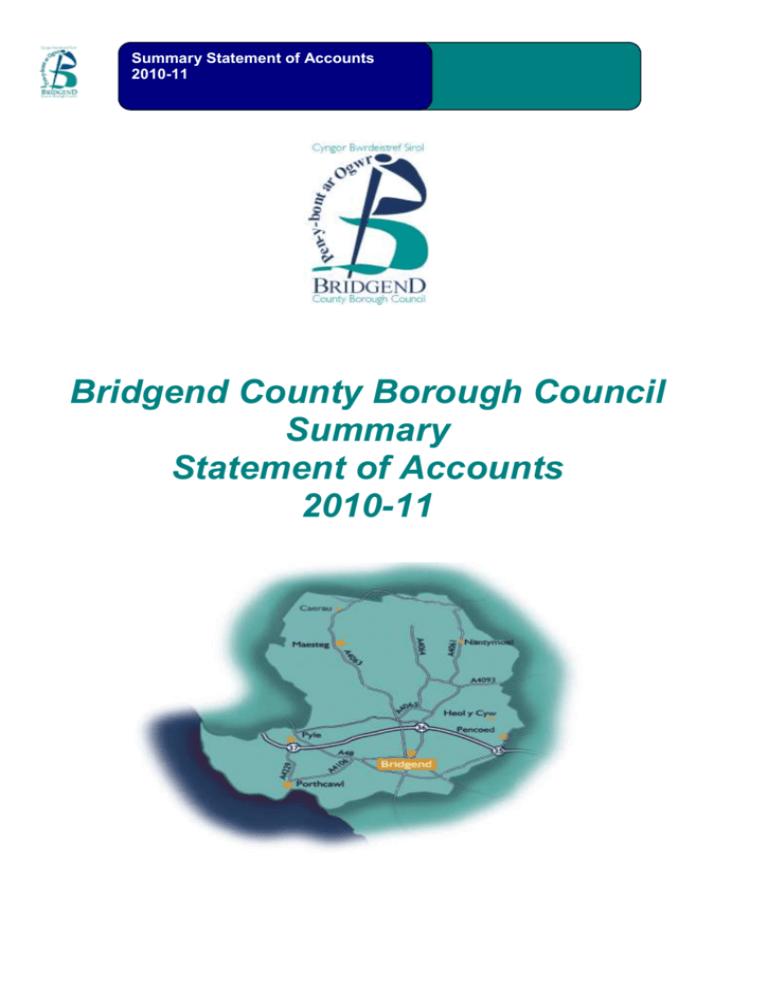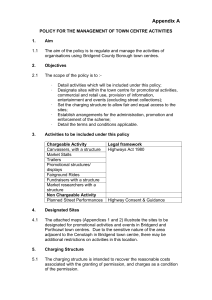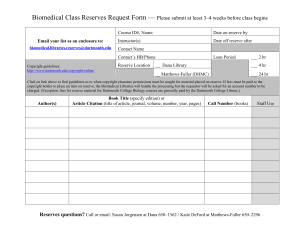Summary Statement of Accounts 2010-11
advertisement

Summary Statement of Accounts 2010-11 Bridgend County Borough Council Summary Statement of Accounts 2010-11 Summary Statement of Accounts 2010-11 This summary of accounts briefly outlines the financial activities of Bridgend County Borough Council for the financial year ended the 31 March 2011. The full Statement of Accounts is published on the Council’s website at www.bridgend.gov.uk The figures in this summary were compiled having regard to proper accounting practices and in accordance with International Financial Reporting Standards (IFRS). The main changes include: the format of the financial statements being redesigned to reflect the requirements of IFRS revised accounting treatment for grants and contributions – grants and contributions received for capital purposes being recognised as income immediately rather than being deferred and matched with depreciation employee benefits being accounted for as they are earned, including holiday pay a greater emphasis on component accounting around the classification of property, plant and equipment. The 2010/11 full Statement of Accounts has been audited by KMPG and went to Audit Committee on the 29 September 2011. The Council has prepared this summary as an aid to understanding the Council’s finances. If you have any comments or suggestions on the format or for further information on the financial affairs of the Council, please contact: Please write to: David Macgregor, Assistant Chief Executive Performance Bridgend County Borough Council Civic Offices Angel Street Bridgend CF31 4WB David.Macgregor@bridgend.gov.uk 1 Summary Statement of Accounts 2010-11 WHAT DID WE SPEND THE MONEY ON The costs of running our services are detailed in the Comprehensive Income & Expenditure Statement. This account shows the total net spending by the Council to provide services and the amount left to be financed from Council Tax and Government Support. Net Net Expenditure Expenditure 10/11 09/10 £'000 £'000 Directorates Children Communities Wellbeing Resources Finance and Property ICT & Customer Contact Corporate Development & Partnerships Legal and Regulatory Services 115,670 25,903 42,982 5,235 7,304 4,168 5,714 112,178 27,804 42,305 12,384 4,287 5,549 206,976 16,155 204,507 15,630 11,802 9,634 244,567 5,997 9,355 235,489 10/11 £'000 175,671 18,058 16,757 44,093 124,752 (172,355) 206,976 09/10 £'000 172,732 17,713 16,936 44,949 117,975 (165,798) 204,507 10/11 £'000 (144,372) (37,714) (62,498) (244,584) 09/10 £'000 (140,425) (35,973) (59,095) (235,493) - Net Cost of Services Add : Payment of Precepts & Levies to Other Organisations eg South Wales Police Authority, South Wales Fire Service Add : Money taken from Reserves & Contingencies Add : Capital Financing Charges Cost of Local Services to be met by Council Tax and Government A BREAKDOWN OF OUR COSTS Employees Premises Transport Supplies and Services Other Costs Less: Grants and Income Net Cost of Services HOW DID WE PAY FOR THIS Where the Money Comes From Revenue Support Grant & General Government Grants Non Domestic Rates Council Tax Total Income 2 Summary Statement of Accounts 2010-11 EFFECT ON COUNCIL FUND The Council Fund is a general reserve in order to fund future unexpected expenditure to minimise the effect on services and future Council Tax bills. There was a small increase on the Fund in 2010-11 of £17k. Balance on Council Fund Cost of Local Services to be met by Council Tax and Government Support Total Income Increase in Council Fund Balance Council Fund Balance at Start of the Year (1 April) Council Fund Balance at End of the Year (31 March) 10/11 £'000 244,567 (244,584) (17) (7,141) (7,158) 09/10 £'000 235,489 (235,493) (4) (7,137) (7,141) CAPITAL SPENDING The Council invests for the future in its buildings, infrastructure, equipment and by acquiring assets by means of capital expenditure. This is accounted for separately from the running costs of the Council’s day to day services. Capital expenditure is funded from borrowing, external grants and contributions and receipts from the sale of the Council’s assets. Details of the capital spend and funding is shown in the below pie charts: Capital Expenditure 10-11 2% 15% Children 29% Communities 10% Wellbeing Housing 22% Finance & Property 21% ICT & Customer Contact Capital Funding 2010-11 % 13% 40% Borrowing External Grants & Cont. Capital Receipts 47% 3 Summary Statement of Accounts 2010-11 The total capital spending during 2010/11 was £29.9m. Assets created, improved or work in progress as a result of this spend included: Bridgend Day Centre Office Accommodation Primary Schools’ Amalgamations Pencoed Park & Ride Safe Routes to Schools WHAT WE ARE WORTH At the end of the financial year, a balance sheet is produced that represents how much the Council’s assets are worth, what is owed to us, what we owe others and how much cash remains. What we are Worth Net Assets Value of Council's Long Term Assets Cash in Bank & Cash Investments Money owed to Bridgend CBC and other Assets Money owed by Bridgend CBC and other Liabilities Pensions Liabilities Total Assets less Total Liabilities The Council's Reserves: Unusable Reserves Revaluation Reserve Capital Adjustment Account Accumulating Absences Account Pension Reserve Financial Instruments Account Usable Reserves Council Fund Capital Grants Unapplied Earmarked Reserves Capital Receipts Reserve Total Reserves 10/11 £'000 518,117 19,152 28,151 (177,710) (226,110) 161,600 09/10 £'000 526,178 14,120 24,876 (166,725) (291,290) 107,159 105,852 251,809 (3,728) (226,110) (5,936) 112,779 256,670 (3,965) (291,290) (6,140) 7,158 389 22,474 11,607 163,515 7,141 195 16,785 14,984 107,159 The Unusable Reserves are not cash reserves and therefore cannot be used for any other purpose. The Council has a legal responsibility to maintain a sensible level of working balances and reserves. The current level of the Council Fund Balance is £7.158 million. Earmarked Reserves are set aside for specific purposes examples include a Major Claims Reserve, a Treasury Management Reserve, an Insurance Reserve and a Financial and HR systems Earmarked Reserve. 4 Summary Statement of Accounts 2010-11 CASH FLOW This shows the net amount of money that has moved into the Council’s bank account over the course of the year. Cash Flow Statement Cash at Bank / (Cash Overdrawn) @ Start of the Year (1 April) Net Cash Movement Cash at Bank / (Cash Overdrawn) @ End of the Year (31 March) 10/11 £'000 4,042 2,083 6,125 FINANCIAL MANAGEMENT Performance Indicator Annual Accounts submitted statute date required Council : date submitted Number of days early Annual Accounts published statute date required Audit Committee : date submitted Number of Days Early 2007/08 2008/09 2009/10 2010/11 30/06/2008 30/06/2009 30/06/2010 30/06/2011 18/06/2008 17/06/2009 N/A * N/A* 12 days 13 days 30/09/2008 30/09/2009 30/09/2010 30/09/2011 24/09/2008 23/09/2009 16/09/2010 29/09/2011 6 days 7 days 14 days 1 day * The Annual Accounts were signed by 30 June but were not required to go to Council due to an amendment to the Accounts & Audit Regulations. The above Performance Indicators show how the Council has produced its Statement of Accounts and submitted them to Audit Committee in advance of the statutory deadline for the past four years. ANNUAL TREASURY MANAGEMENT PERFORMANCE INDICATORS Debt Performance Indicator 2010/11 Bridgend CBC Welsh Unitary Local Authorities Average Rate of Average Rate for outstanding PWLB* Debt at PWLB 31/03/11 Debt at 31/03/11 4.73% 5.71% -0.98% *Public Works Loan Board 5 All UK Authorities Average Rate for outstanding PWLB Debt at 31/03/11 5.20% -0.47% 09/10 £'000 1,631 2,411 4,042 Summary Statement of Accounts 2010-11 Investments Performance Indicator 2010/11 Bridgend CBC 7 day LIBID 3 month LIBID Average Rate of (London Inter(London InterReturn on Bank Bid rate) as Bank Bid rate) as Investments as at at 31/03/11 at 31/03/11 31/03/11 1.02% 0.46% +0.56% 0.69% +0.33% Bank Rate 2010/11 as at 31/03/11 0.50% +0.52% The above Performance Indicators show the adequacy of the treasury function in 2010/11. The first table shows a debt performance indicator of the average portfolio rate of interest compared to an appropriate average available. The second table shows an investments performance indicator of the actual rate of interest in 2010/11 compared to the LIBID rate and the bank rate. 6







